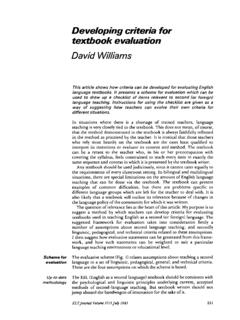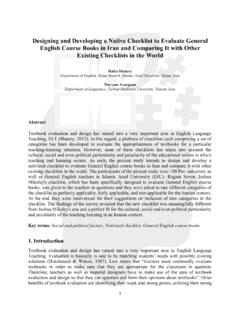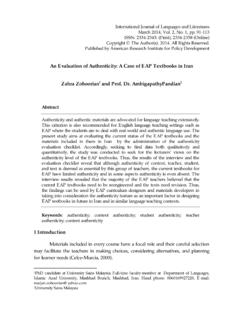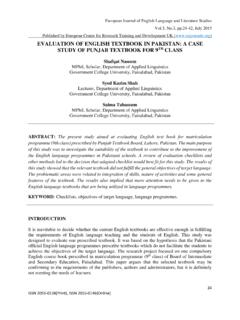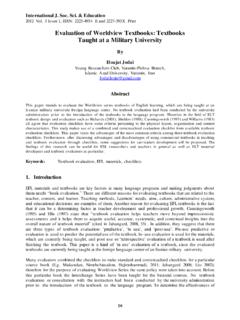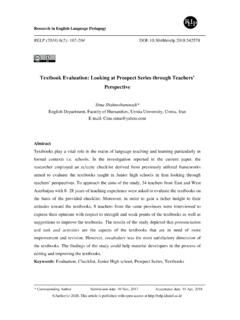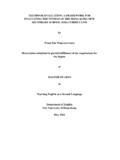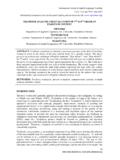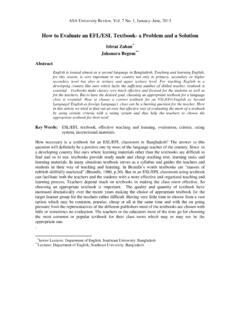Transcription of Evaluating ELT textbooks and materials Leslie Sheldon
1 Evaluating ELT textbooks andmaterialsLeslie SheldonEL T coursebook publishing is a multi-million pound industry, yet the wholebusiness of product assessment is haphazard and are often seen by potential consumers teachers, learnersand educational purchasers as market ephemera requiring invidiouscompromises between commercial and pedagogical demands. Some prac-tical and theoretical reasons for such grassroots discontent are discussed,as are previous textbook studies and qualitative'checklists'. The state of theinformational assistance available to intending purchasers is also exam-ined. Finally, a set of 'common core'qualitative criteria is advanced, whosepurpose it would be to make evaluation and selection more systematic andinformed.
2 *According to Hutchinson and Waters, textbook evaluation is basically astraightforward, analytical 'matching process: matching needs to availablesolutions' (Hutchinson and Waters 1987:97). My own view is that this issueis rather more emotive and controversial for teachers; many would agreewith Swales (1980) that textbooks , especially coursebooks, represent a'problem', and in extreme cases are examples of educational failure. Iwould like to explore the reasons for such strong reactions, and to putforward possible evaluative solutions. I wish to concentrate on coursebooksbecause, whether we like it or not, these represent for both students andteachers the visible heart of any ELT programme.
3 The selection of aparticular core volume signals an executive educational decision in whichthere is considerable professional, financial and even political high profile means that the definition and application of systematiccriteria for assessing coursebooks are vital. Supplementary textbooks andmaterials on the other hand may not carry the same burden. The evaluativecriteria for these can to some extent remain implicit, or be allowed to definethemselves more informally in the local attitudm* ELT coursebooks evoke a range of responses, but are frequently seen byteachers as necessary evils. Feelings fluctuate between the perception thatthey are valid, labour-saving tools, and the doleful belief that 'masses ofrubbish is skilfully marketed' (Brumfit 1980:30).
4 In basic terms, thereseems to be a 'coursebook credibility gap' (Greenall 1984:14) because ofemphatic contradictions and potential conflicts of interest in their creation,commercial exploitation, public assessment, selection, and ultimate class-room use. ELT books are frequently seen as poor compromises betweenwhat is educationally desirable on the one hand and financially viable onthe other. In simple terms, they often do not seem to provide good value TJournal Volume 42/4 October 1988 Oxford University Press 1988 23 7In the attempt to make the volumes in question seem suitable for alllearners in all situations, excessive claims by some authors and publishershave made such disaffection inevitable.
5 Staffroom conversations aboutwhich parts of a specific textbook can be salvaged for actual teachingpurposes are a constant reminder of the belief, publisher's blurbs notwith-standing, that 'The whole business of the management of language learningis far too complex to be satisfactorily catered for by a pre-packaged set ofdecisions embodied in teaching materials ' (AUwright 1981:9).The sheer labour-intensiveness of developing classroom materials , thepressures of heavy timetables, and the highly restrictive nature of mostteaching situations nevertheless force the teacher (or educational pur-chaser) to rein in his or her reservations, and to choose a book which onlyapproximates to the needs of the local context.
6 It is not always a happycompromise, and is most often made in haste and with a paucity ofsystematically applied criteria. Coursebooks are perceived by many to bethe route map of any ELT programme, laying bare its shape, structure, anddestination, with progress, programme, and even teacher quality beingassessed by learners in terms of sequential, unit-by-unit coverage. In thissituation, wrong selection can be a particularly keen reason for a textbook is imposed on both parties by a higher authority, andwhen there is no possibility of change or modification, the discontent is noless acute for being is a cruel paradox that for students, teacher-generated material (whichpotentially has a dynamic and maximal relevance to local needs) often hasless credibility than a published textbook , no matter how inadequate thatmay be.
7 Against the public endorsement implied by printed covers, home-grown materials appear in a poor light. This is especially true for theseemingly disconnected snippets of authentic texts or teacher-createdworksheets that are a consequence of the 'communicative' approach. Quitesimply, it would seem that coursebooks exert a kind of'backwash' is particularly true where their form and content is restricted becauseprogrammes are linked to an English Language qualification, probably themost common ELT situation frustrations can be assuaged, at least potentially, when localtextbooks are developed in order to accommodate the on-the-spot needs oflearners and preferences of teachers.
8 For the future, one might speculatethat with the expansion in desk-top publishing via microcomputers, evengreater scope for interaction could one day be possible, with the textbook aswe know it eventually disappearing; it might be replaced instead by a'published' core materials program, which the teacher could modify andsupplement as required, hard copies being placed between 'glossy' text-book covers to satisfy student expectations about format and about qualityof the fact is that coursebooks are here, and are even exploited intraditional environments as a method of controlling large classes of learn-ers. Such pedagogical experiences generate expectations about what acoursebook should contain, what it should look like, and how it should beused.
9 These perceptions are frequently carried over into environmentswhere more freedom and choice are in reality theoretical Other, more immediate reasons for disappointment seem partly to do withmndprmctieml a variety of common design flaws on one level, and a scepticism about theprobtmmM theoretical premises of many coursebooks on another: all this despite the238 Leslie Shtldonfact that 'to put a book on the open market implies a moral contract that thebook has been cleared of basic faults' (Brumfit 1980:30). That the samecomplaints come up repeatedly suggests a violation of this implicit agree-ment, and a substantive mismatch between what is produced and whatteachers would like to have.
10 Of course, the situation is not helped by the factthat textbooks are necessarily static and a litde outdated, not least becauseof the long delays between writing and publication. The feedback loop forhomegrown materials is of course much shorter and problems include such recurring faults as the failure to describeadequately the language levels of target learners (the indiscriminate use ofterms like 'beginner' and 'intermediate' abounds); the production of work-books or exercise pages that demand microscopic handwriting; the omis-sion of course rationales stating exactly who the book is intended for, or howthe material is selected and sequenced; a surrender to the economic pres-sures that demand a maximum textual density on each page.
